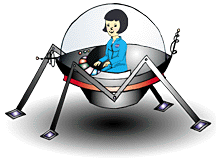![]()
 |
Can You Believe it?Since its discovery in 1801, Ceres has been considered a comet, a planet, an asteroid, and a dwarf planet. |
|
Italian Giuseppe Piazzi discovered Ceres on January 1, 1801 while he was searching for a star. He first believed that he had discovered a comet, but he was not confident in his belief. By the end of the year, with the help of other astronomers, he had collected enough evidence to call it a planet. It takes approximately 4.6 Earth years for Ceres to make one revolution around the Sun. Ceres is located 415 million kilometers from the Sun and revolves around the Sun in an orbit between Mars and Jupiter. In 1802, additional objects were also found to be orbiting in the same area. Sir William Herschel labeled these objects as asteroids, so in 1802 Ceres became known as an asteroid, not a planet. Ceres was the largest known asteroid in the asteroid belt until 2006. In 2006, the International Astronomical Union formed a new class of solar system objects known as dwarf planets. By definition a dwarf planet is spherical and travels in an orbit around the Sun. Ceres fit the definition perfectly. Because Ceres is spherical, it is unlike the majority of the members of the asteroid belt. Its composition is also slightly different than its neighbors in the belt. Its surface is probably covered with a mixture of water ice, carbonates, and clays. This leads astronomers to believe that it formed differently from the other bodies in the asteroid belt. It is now believed that Ceres formed 4.6 billion years ago when the solar system was forming. Apparently, Ceres never accumulated enough matter to get larger than the 950 kilometers in diameter that it currently is. Ceres contains one-third of the mass found in the asteroid belt. Scientists believe that Ceres has a rocky core and an icy mantle. Some scientists also believe that it has a liquid water layer in its interior. This possibility makes Ceres very intriguing to scientists that are searching for signs of extraterrestrial life. NASA has launched a probe called Dawn, whose mission is to travel to the asteroid belt. It will first travel to observe the asteroid Vesta. After collecting data from Vesta, Dawn will intercept with Ceres where it will observe its surface features and collect data about its chemical composition. |
|
A QuestionIf Ceres were to suddenly depart the asteroid belt, by what percentage would the mass of the belt be decreased? |
| The Facts |
Did you know? |
The Answer |
![]()
| Show me the Level 1 version of this page. |
The StarChild site is a service of the High Energy Astrophysics Science Archive Research Center (HEASARC), within the Astrophysics Science Division (ASD) at NASA/ GSFC.
StarChild Authors: The StarChild Team
StarChild Graphics & Music: Acknowledgments
StarChild Project Leader: Dr. Laura A.
Whitlock
Curator:
Responsible NASA Official: